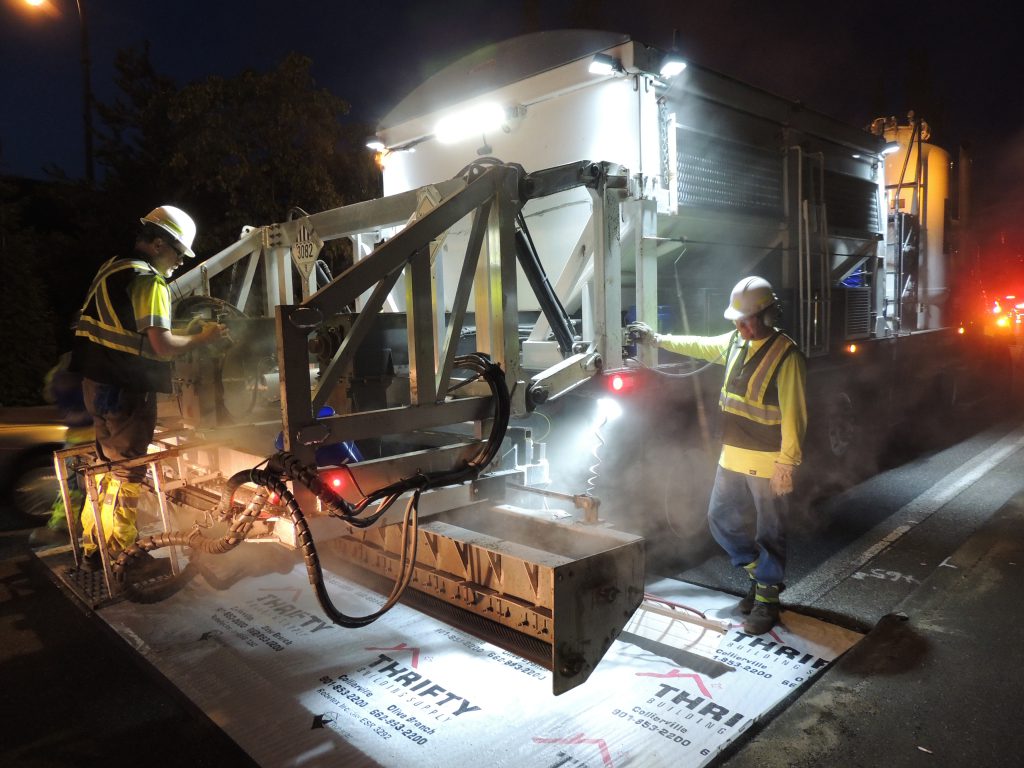
Drivers are getting a serious grip at 14 high-collision locations throughout the Lower Mainland and Vancouver Island with the application of high friction surface treatment.
High friction? Yeah, basically the roads at four interchange off-ramps and 10 intersections are getting coarser to reduce skidding, and thus, decrease braking distances.
Here’s how it works: using an automated truck-mounted machine, crews lay down specialized aggregate overtop a resin binder. The type of aggregate is called calcined bauxite, which is extremely hard and retains the sharp edges produced from crushing – a combination that provides a big boost to skid resistance.
Watch contractor DBI Services in action:
As you can see below, crews must hit the sweet spot when laying down the binder – too little, and it won’t hold the aggregate in place; too much, and there won’t be enough exposed aggregate to come in contact with, and help stop, rolling tires. Think of it as the Goldilocks principle.

The applications are 150 metres to 250 metres, long depending on the location, and the distances were determined based on where typical traffic queues form and vehicles begin braking.
We partnered with ICBC to identify the 14 locations based on a review of collision and claims data:
Lower Mainland
- Highway 1 – Capilano Road off-ramp (westbound) in North Vancouver
- Highway 1 – Lonsdale Avenue off-ramp (eastbound/westbound) in North Vancouver
- Highway 1 – Willingdon Avenue off-ramp (eastbound) in Burnaby
- Highway 1 – Brunette Avenue off-ramp (eastbound/westbound) in Coquitlam
- Highway 7 – 203 Street intersection (eastbound) in Maple Ridge
- Highway 7 – 207 Street intersection (eastbound) in Maple Ridge
- Highway 7 – Kennedy Road intersection (eastbound/westbound) in Pitt Meadows
- Highway 7 – Laity Street intersection (eastbound) in Maple Ridge
- Highway 10 – 120 Street/Scott Road intersection (eastbound/westbound) in Surrey
- Highway 10 – 176 Street intersection (eastbound/westbound) in Surrey
Vancouver Island
- Highway 17 – Cloverdale Avenue intersection (southbound) in Saanich
- Highway 17 – Elk Lake Drive intersection (northbound/southbound) in Saanich
- Highway 17 – Sayward Road intersection (northbound) in Saanich
- Highway 17 – Mt. Newton Cross Road intersection (northbound/southbound) in Saanich
Friction between tire and road is such an important factor for stopping vehicles quickly. This surface treatment could have a significant impact in reducing collisions, especially in wet conditions and high-speed situations. This initial round of high friction surface treatment is being done as a pilot. We’ll evaluate its success before considering its application at other locations.
Have you driven on this surface treatment yet? What was it like? Let us know in the comments below.
Join the discussion